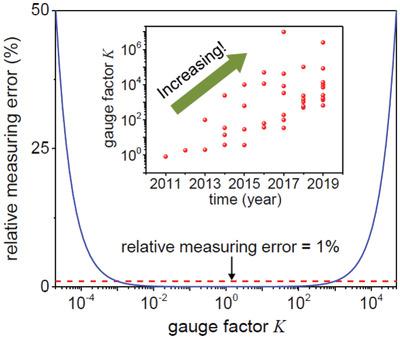当前位置:
X-MOL 学术
›
Adv. Electron. Mater.
›
论文详情
Our official English website, www.x-mol.net, welcomes your feedback! (Note: you will need to create a separate account there.)
Overlarge Gauge Factor Yields a Large Measuring Error for Resistive‐Type Stretchable Strain Sensors
Advanced Electronic Materials ( IF 6.2 ) Pub Date : 2020-09-13 , DOI: 10.1002/aelm.202000618 Shuang Li 1, 2 , Guodong Liu 1, 2 , Liwu Wang 3 , Guanhui Fang 3 , Yewang Su 1, 2, 4
Advanced Electronic Materials ( IF 6.2 ) Pub Date : 2020-09-13 , DOI: 10.1002/aelm.202000618 Shuang Li 1, 2 , Guodong Liu 1, 2 , Liwu Wang 3 , Guanhui Fang 3 , Yewang Su 1, 2, 4
Affiliation

|
Stretchable strain sensors have recently attracted great attention due to their extensive applications in advanced devices. Plenty of work has been devoted to enlarging the gauge factor (GF) (reaching as high as 107), since the conventional wisdom holds that a high GF indicates a low limit of detection and a high resolution of a sensor. Here, the effects of the GF on the measurement accuracy is investigated for resistive‐type strain sensors, via the basic approach based on Ohm's law and the commonly used method of Wheatstone bridge, respectively. It is found that a bigger GF is not always better for improvement of the measurement accuracy, which is contrary to conventional wisdom. Overlarge gauge factor yields a large measuring error for resistive‐type stretchable strain sensors (reaching the measuring error of 50% for GF = 5 × 104 under a typical measurement condition). This finding is of much significance for providing theoretical guidance for the sensor design and avoid more efforts on overlarge GF.
中文翻译:

对于电阻型可拉伸应变传感器,过大的测量系数会产生较大的测量误差
由于可拉伸应变传感器在先进设备中的广泛应用,最近引起了极大的关注。大量工作致力于扩大量表系数(GF)(达到10 7),因为传统观点认为,高GF表示检测限低且传感器分辨率高。在这里,分别通过基于欧姆定律的基本方法和惠斯通电桥的常用方法,研究了电阻式应变传感器的GF对测量精度的影响。已经发现,较大的GF并非总是对改善测量精度总是更好,这与传统观点相反。对于电阻型可拉伸应变传感器,较大的规格系数会产生较大的测量误差(在典型的测量条件下,对于GF = 5×10 4,达到50%的测量误差)。这一发现对于为传感器设计提供理论指导并避免对超大型GF进行更多努力具有重要意义。
更新日期:2020-11-19
中文翻译:

对于电阻型可拉伸应变传感器,过大的测量系数会产生较大的测量误差
由于可拉伸应变传感器在先进设备中的广泛应用,最近引起了极大的关注。大量工作致力于扩大量表系数(GF)(达到10 7),因为传统观点认为,高GF表示检测限低且传感器分辨率高。在这里,分别通过基于欧姆定律的基本方法和惠斯通电桥的常用方法,研究了电阻式应变传感器的GF对测量精度的影响。已经发现,较大的GF并非总是对改善测量精度总是更好,这与传统观点相反。对于电阻型可拉伸应变传感器,较大的规格系数会产生较大的测量误差(在典型的测量条件下,对于GF = 5×10 4,达到50%的测量误差)。这一发现对于为传感器设计提供理论指导并避免对超大型GF进行更多努力具有重要意义。


























 京公网安备 11010802027423号
京公网安备 11010802027423号